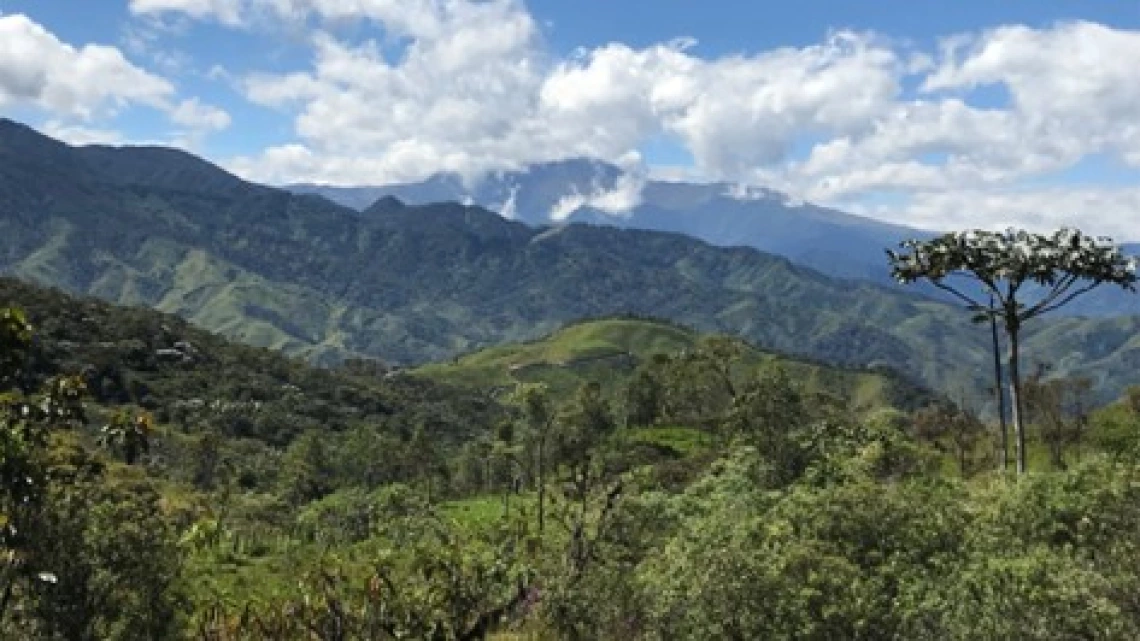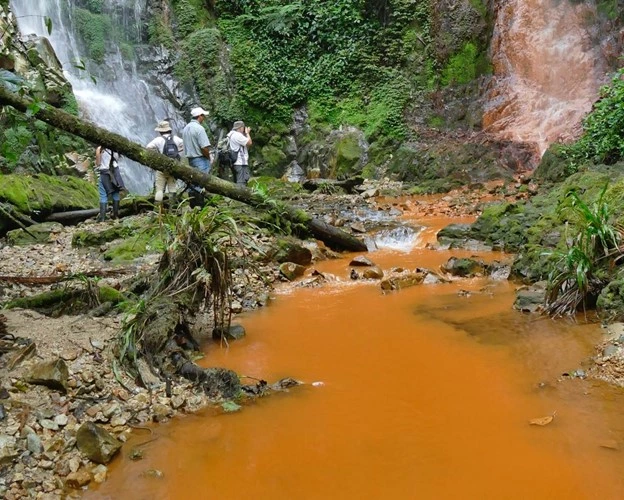Views from Diego’s Porch: Water-Monitoring as Environmental Activism in Intag, Ecuador

The view from Diego’s porch
My friend Diego1 loves showing off the view from his porch—and I don’t blame him. In the foreground, a lush green patchwork of agricultural land and protected forest is draped over the dramatic peaks of the tropical Andes. Meanwhile, against the backdrop of a bright blue sky, a faraway volcano is shrouded in misty clouds. As we sit, Diego points out distant trees, one by one, identifying each by its distinctive canopy: guarumbo, magnolia, cedro. On a moonless night, he assures me, the thousands of stars’ only earthly companion is a faint glow emanating from Quito, Ecuador’s capital city, nestled in a high valley a half day’s journey away. Enjoying the sights on this summer afternoon in 2018, it is hard to imagine the profound destruction that threatens this landscape, and that Diego and his neighbors so fear.
Returning my gaze to my notes, I ask Diego about the role of scientific data in his decades-old and ongoing struggle to prevent the onset of large-scale mining in the protected forest upstream from his home. “Well, those data are essential to our legal fight,” he explains, “so that we can prove to the Ecuadorian state that the water has been impacted.” During a water monitoring expedition a few days later, Victor, another local activist, expanded on why scientific data are essential to their legal strategy: “[Scientific data] help us to defend our rights,” Victor explained, “and the rights of our water, which the mining companies are violating.” In 2008, Ecuador became the first nation in the world to grant constitutional rights to natural entities like forests and streams, including their rights to exist and to “the regeneration of their life cycles, structure, functions, and evolutionary processes.”
These comments sum up much of what I learned about the relationship between science and the law on my first trip to Ecuador in 2018. In those days, I was an undergraduate student of anthropology and political economy working on an ethnographic study of resistance to mining operations in the village of Junín. At that time, Junín—located within “la zona de Intag,” a cloud forest region of the Province of Imbabura—was the only community in the region where exploratory drilling had already begun. In addition to the above, I learned that Intag is part of the Tropical Andes Biodiversity Hotspot, which features the greatest plant, mammal, amphibian, and bird diversity of any region in the world and his home to an extraordinary number of endemic and endangered species. I also learned that the forests near Victor’s and Diego’s homes are believed to contain between 318 and 954 million tonnes of copper ore, and that a series of foreign corporations have long been interested in extracting those reserves. Finally, I learned that, according to some projections, that extraction would result in the forced relocation of at least four communities, mass desertification, the extinction of several endemic species, and a severe deterioration of local water quality.

“The Twins” waterfalls in Junín, one of which has changed markedly since the onset of exploratory drilling
As I was finishing up that project, I realized that while I had learned a great deal from spending time with Diego, Victor, and other activists, I was about to take that knowledge and run — I hadn’t done anything to aid them in their struggle, nor did I have plans to do so. Alarmed by this lack of reciprocity (and encouraged by some new Ecuadorian friends), I resolved to leverage the resources to which I had access as a US-based university student. I aimed to support community-led environmental monitoring initiatives and a network of local cooperatives that provide environmentally sustainable economic alternatives to mining work for local people in Intag. Since 2018, I’ve spent more than six months there over the course of four visits, and I’ve secured tens of thousands of dollars in grant funding to contribute toward these goals. I’ve provided technical assistance to strengthen the existing water quality monitoring campaign in Junín, which involves the biweekly collection of pH, electrical conductivity, dissolved solids, and temperature data and the biannual collection of water samples for laboratory analyses of heavy metals concentrations. I’ve helped to initiate similar campaigns in several additional communities that are newly threatened by exploratory mining operations. I’ve conducted dozens of interviews with residents of Junín and surrounding communities, documenting their recollections of changes to local water quality since the onset of exploratory drilling. And aside from all this, I’ve helped strengthen three local cooperatives that provide sustainable alternatives to mining work for local people by delivering marketing services, machinery, educational workshops, and infrastructural improvements.

Environmental monitoring activities in 2019
As this work has progressed, however, the needs of my community partners—and, therefore, the support that I aim to provide them—have evolved. Rather than support for data collection, they tell me, what they really need now is someone who can help them publish a study of the relationship between exploratory mining activity and local water quality in a peer-reviewed scientific journal. This, they believe, will lend a degree of legitimacy to our findings, making them suitable for presentation in a court of law.
Accordingly, since beginning my graduate studies at the University of Arizona, I have been working to develop the skills I will need to undertake a thorough analysis of our data on changes in water quality, including both our quantitative (pH, EC, etc.) and qualitative interview data. To this end, I have completed or enrolled in multiple courses in GIS technology, aqueous environmental geochemistry, and ethnographic discourse analysis. Moreover, I have begun working with faculty advisors in these fields to help me design the study that my community partners have envisioned. During my CLIMAS Fellowship year, I hope we will achieve our goal of coauthoring this study and submitting it to an appropriate journal.
The work goes on; as I write, I am preparing to leave for Ecuador once again, where I will continue working in pursuit of this goal. A few days from now, I expect to find myself sitting on Diego’s porch once more. I sure hope the view hasn’t changed much.
1All names appearing in this text have been changed to protect the identities of research participants.
This project is supported by the CLIMAS Environment & Society Fellowship program, the Arizona Institute for Resilience, and the Office for Research, Innovation, and Impact at the University of Arizona. Graduate fellows conduct collaborative and societally-informed research that addresses pressing environmental challenges around the world.

